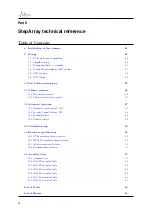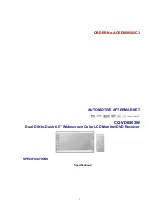
1.2
Loudspeaker arrays
Using many non-directional loudspeakers often leads to poor intelligibility: all loudspeakers contribute to the
reverberation, while only a few contribute to direct sound.
Using highly directionnal loudspeakers is an easier solution in large spaces because only few diffusers are needed.
In addition to improved acoustic performance and reduced cost, it minimizes the aesthetical impact of the public
address system.
Sound quality
Intelligibility is not enough for good perceived sound quality. Another very important aspect is that every listener has
an adequate sound pressure level (SPL), which implies that the public address system provides an even coverage
of the audience area. This can be acheived with an accurate control of the loudspeaker directivity.
Acoustic comfort also implies a wide frequency bandwidth and low harmonic distortion.
The most important goal of a public address system is to provide a strong and constant direct sound over the
entire audience area, and minimize the energy emitted elsewhere.
1.2
Loudspeaker arrays
Loudspeaker arrays are often the best solution to providing strong and constant direct sound over the audience.
Indeed, although a distributed public address system might yield a relatively constant SPL over the audience using
a large number of loudspeakers, it is usually not able to provide satisfactory speech intelligibility when reverberation
in the room is high. In addition, it usually has a rather negative impact on the visual aspect of the room.
In contrast, high speech intelligibility can be obtained with a limited number of loudspeaker arrays (often only 1 or
2) in a large and highly reverberant room with minimum impact on the aesthetics of the room.
It is easy to calculate the shape of the wave front that should be radiated by a loudspeaker array in order to yield
constant SPL over the entire audience area, and minimize sound energy emitted elsewhere. A J-shape wave
front is obtained, in which the local curvature depends on the focal distance, as illustrated on figure
. In order
to generate such a wave front, one can align loudspeakers along the J-shape as in
geometric arrays
(figure
) [C-HEIL], or place loudspeakers on a vertical line and rely on the filtering of each individual
loudspeaker as in
electronic arrays
(figure
) [DSP directivity]. The latter case corresponds to
column loudspeakers, which can be flush mounted on a wall. Advantages and disadvantages of both array types
are discussed in [DGRC-Arrays].
Wave
front
r1
r2
d1
d2
x1
x2
Listening plan
Figure 2: J-shape wave front required in order to radiate constant SPL over the listening plan.
Last update: December 23, 2010
7








































